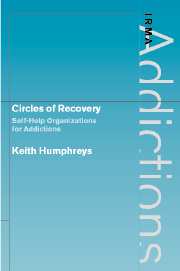Book contents
- Frontmatter
- Contents
- Acknowledgements
- 1 Definitions, scope, and origin of the health-related self-help group movement
- 2 An international tour of addiction-related mutual-help organizations
- 3 Does self-help group participation lead to positive addiction-related, psychiatric, and medical outcomes?
- 4 A different perspective on change in self-help organizations: spirituality, identity, life stories, friendship networks, and politicization
- 5 How should government agencies, healthcare organization, and clinicians interact with self-help organizations?
- Epilogue: summing up, moving forward
- References
- Index
1 - Definitions, scope, and origin of the health-related self-help group movement
Published online by Cambridge University Press: 31 July 2009
- Frontmatter
- Contents
- Acknowledgements
- 1 Definitions, scope, and origin of the health-related self-help group movement
- 2 An international tour of addiction-related mutual-help organizations
- 3 Does self-help group participation lead to positive addiction-related, psychiatric, and medical outcomes?
- 4 A different perspective on change in self-help organizations: spirituality, identity, life stories, friendship networks, and politicization
- 5 How should government agencies, healthcare organization, and clinicians interact with self-help organizations?
- Epilogue: summing up, moving forward
- References
- Index
Summary
Points of departure
The use and abuse of alcohol, opiates, cocaine, nicotine, and other substances is arguably the greatest threat to public health in the developed world. Substance use causes half a million deaths annually in the USA alone, and is a contributing factor to countless morbidities, not to mention tremendous human suffering (Horgan, Skwara, & Strickler, 2001). Accordingly, developed societies have created complex networks of professionally operated health and social welfare programs to help the millions of individuals whose substance use harms themselves and others. Individuals with substance-abuse problems can thus seek help from addiction-treatment professionals in acute inpatient treatment programs, detoxification units, day hospitals, evening intensive outpatient programs, residential therapeutic communities, halfway houses, psychiatric clinics, psychologists' offices, social work agencies, and primary medical care practices, among many other settings. Help-seekers also can avail themselves of the advice of religious leaders, trusted friends, family members, and co-workers. Yet no matter how sparsely or generously all of the above potential sources of help are provided in a given society, a significant number of addicted individuals turn to each other for support, guidance, understanding, practical advice, and a sense of belonging by joining self-help organizations.
The mutual-help organizations with which addicted individuals affiliate vary enormously in their histories, structures, philosophies, procedures, and membership. Abstainers Clubs broadcast members' life stories on Polish television, whereas Alcoholics Anonymous shuns all efforts at media promotion. The All Nippon Sobriety Association receives grants from the Japanese government, whereas Cocaine Anonymous refuses outside financial support.
- Type
- Chapter
- Information
- Circles of RecoverySelf-Help Organizations for Addictions, pp. 1 - 32Publisher: Cambridge University PressPrint publication year: 2003

